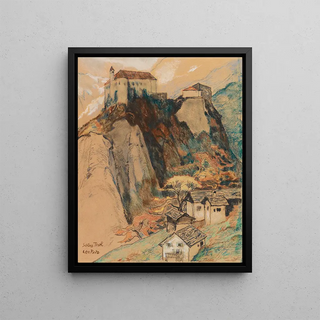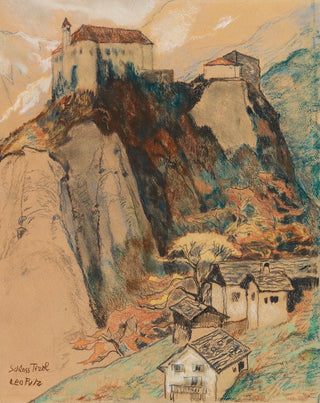Art print | Château du Tyrol - Leo Putz


View from behind

Frame (optional)
Château du Tyrol art print by Leo Putz – Captivating introduction
Leo Putz's "Château du Tyrol" art print is an invitation to immerse oneself in a world where nature and architecture meet with striking harmony. This painting, evoking the majesty of alpine landscapes, transports the viewer on a visual journey into the heart of Tyrolean mountains. The vibrant colors and delicate shapes intertwine to create an atmosphere that is both serene and enchanting. Every brushstroke seems to tell a story, that of a place rich in history and mystery. The art print of this work allows appreciation of the artist's finesse and adds a touch of elegance to any space.
Style and uniqueness of the work
Leo Putz's style is distinguished by his ability to capture light and shadow, thus giving an almost three-dimensional dimension to his landscapes. In "Château du Tyrol," shades of blue and green blend to evoke the freshness of alpine pastures, while touches of golden light illuminate the castle, making it almost alive. The artist uses a rich and varied palette, where each color is carefully chosen to create an atmosphere of tranquility and beauty. His impressionist approach is expressed through quick, fluid brushstrokes that bring the scene to life while leaving room for imagination. The viewer is thus invited to explore every corner of the painting, discovering hidden details that enrich the visual experience.
The artist and his influence
Leo Putz, born in 1869, is a painter whose work was deeply influenced by the landscapes of his childhood in Bavaria and Austria. His artistic training, marked by travels across Europe, allowed him to incorporate elements from different artistic movements while developing a personal style. Putz is often associated with the Vienna Secession movement, which advocated a break with academic conventions. His work, although rooted in tradition, is characterized by a modernity that is uniquely his own. Themes of nature, light, and architecture recur in his works, making him an essential artist for understanding the evolution of painting in the early 20th century.

Matte finish

View from behind

Frame (optional)
Château du Tyrol art print by Leo Putz – Captivating introduction
Leo Putz's "Château du Tyrol" art print is an invitation to immerse oneself in a world where nature and architecture meet with striking harmony. This painting, evoking the majesty of alpine landscapes, transports the viewer on a visual journey into the heart of Tyrolean mountains. The vibrant colors and delicate shapes intertwine to create an atmosphere that is both serene and enchanting. Every brushstroke seems to tell a story, that of a place rich in history and mystery. The art print of this work allows appreciation of the artist's finesse and adds a touch of elegance to any space.
Style and uniqueness of the work
Leo Putz's style is distinguished by his ability to capture light and shadow, thus giving an almost three-dimensional dimension to his landscapes. In "Château du Tyrol," shades of blue and green blend to evoke the freshness of alpine pastures, while touches of golden light illuminate the castle, making it almost alive. The artist uses a rich and varied palette, where each color is carefully chosen to create an atmosphere of tranquility and beauty. His impressionist approach is expressed through quick, fluid brushstrokes that bring the scene to life while leaving room for imagination. The viewer is thus invited to explore every corner of the painting, discovering hidden details that enrich the visual experience.
The artist and his influence
Leo Putz, born in 1869, is a painter whose work was deeply influenced by the landscapes of his childhood in Bavaria and Austria. His artistic training, marked by travels across Europe, allowed him to incorporate elements from different artistic movements while developing a personal style. Putz is often associated with the Vienna Secession movement, which advocated a break with academic conventions. His work, although rooted in tradition, is characterized by a modernity that is uniquely his own. Themes of nature, light, and architecture recur in his works, making him an essential artist for understanding the evolution of painting in the early 20th century.






